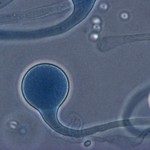Lien vers Pubmed [PMID] – 25535313
Am. J. Trop. Med. Hyg. 2015 Feb;92(2):270-3
A 30-year-old woman with a history of contact lens wear and exposure to swimming pool water in Thailand presented with a non-responsive, progressive corneal ulcer of the right eye. Confocal microscopy evidenced septate linear branching structures, raising suspicion of fungal keratitis. She was promptly treated with topical antibiotics and both topical and intravenous caspofungin plus voriconazole. Worsening of the clinical picture after 1 month of intensive medical therapy led to a large therapeutic penetrating keratoplasty being performed. Corneal cultures grew a mold-like organism, which was identified by sequencing as Pythium insidiosum, an aquatic oomycete. After 4 years of follow-up, the graft exhibits no infection relapse, but graft transparency has been lost after two rejection episodes. Keratoplasty combined with antifungal treatment may offer a cure to P. insidiosum keratitis, although long-term preservation of corneal transparency is difficult to obtain.



